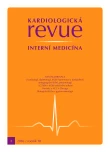Use of rivaroxaban in the prevention of cerebrovascular accident in a patient with chronic heart failure and nonvalvular atrial fibrillation – a case study
Authors:
F. Málek; D. Vondráková; J. Škoda; P. Neužil
Authors‘ workplace:
Ambulance srdečního selhání a hypertenze, Kardiocentrum, Nemocnice Na Homolce, Praha
Published in:
Kardiol Rev Int Med 2016, 18(2): 130-132
Overview
Rivaroxaban is a direct oral factor Xa inhibitor indicated for prevention of stroke in patients with nonvalvular atrial fibrillation. A real-life case study shows the use of rivaroxaban in primary prevention of stroke in a patient with chronic heart failure and high risk of a thromboembolic event and a moderate risk of bleeding. The case report emphasises the need of repeated laboratory examinations in such vulnerable patients with monitoring of renal parameters during cardiac decompensation episodes.
Keywords:
nonvalvular atrial fibrillation – heart failure – renal function – anticoagulation therapy – rivaroxaban
Sources
1. Patel MR, Mahaffey KW, Garg J et al. The ROCKET- AF Investigators. Rivaroxaban versus warfarin in nonvalvular atrial fibrillation. New J Engl Med 2011; 365: 883– 891. doi: 10.1056/ NEJMoa1009638.
2. Špinar J, Vítovec J. Studie ROCKET-AF – konec warfarinu na obzoru? Kardiol Rev Int Med 2011; 13: 106– 108.
3. Karetová D, Bultas J. Nová perorální antitrombotika v prevenci a léčbě trombembolizmu. Kardiol Rev Int Med 2012; 14: 88– 92.
4. Cleland JG. Anticoagulant and antiplatelet therapy in heart failure. Curr Opin Cardiol 1997; 12: 276– 287.
5. Diet F, Erdmann E. Thromboembolism in heart failure: who should be treated? Eur J Heart Fail 2000; 2: 355– 363.
6. Dries DL, Rosenberg YD, Waclawiw MA et al. Ejection fraction and risk of thromboembolitic events in patients with systolic dysfunction and sinus rhythm. J Am Coll Cardiol 1997; 29: 1074– 1080.
7. Howell MD, Geraci JM, Knowlton AA. Congestive heart failure and outpatient risk of venous tromboembolism: a retrospective, case-control study. J Clin Epidemiol 2001; 54: 810– 816.
8. Pisters R, Lane DA, Nieuwlaat R et al. A novel user-friendly score (HAS-BLED) to assess one-year risk of major bleeding in atrial fibrillation patients: The Euro Heart Survey. Chest 2010; 138: 1093– 1100. doi: 10.1378/ chest.10-0134.
9. Roldán V, Marín F, Fernández H et al. Predictive value of the HAS-BLED and ATRIA bleeding scores for the risk of serious bleeding in a "real-world" population with atrial fibrillation receiving anticoagulant therapy. Chest 2013; 143: 179– 184.
Labels
Paediatric cardiology Internal medicine Cardiac surgery CardiologyArticle was published in
Cardiology Review

2016 Issue 2
Most read in this issue
- Fixed-dose combinations in dyslipidemy treatment
- Sacubitril-valsartan (LCZ696) in the treatment of heart failure
- Fixed-dose combination therapy for hypertension
- Fixed-dose combination in pulmonology
